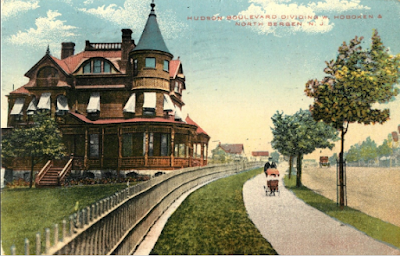"The Great White Hurricane"
As we yet again dig out; Winter Storm Quinn blanketed North Bergen with nearly a foot of snow, even though my father said he only shoveled half that. There was rain, sleet, snow, snow thunder, snow lightening and more snow. It was a storm for the ages...kind of. When all was said and done it was another typical March nor'easter. Today's storm may have caused major inconveniences, but it was no where near as devastating as The Great White Hurricane, The Great Blizzard of 1888. The storm that occurred 130 years ago lasted three days, March 11th to the 14th. The storm crippled the northeast enveloping some parts in up to 58 inches of snow!
Jersey Journal March 14, 1888
Courtesy of the Jersey Journal Archives
Jersey City Library
Unfortunately, at this time, no known photos of North Bergen from the 1888 storm are known to exist. Perhaps so because the town was still sparsely populated with neighborhoods spread across the current town. Neighborhoods with names like Weavertown, Homestead, Buena Vista, (downtown) as well as areas like New Durham, Van Glanhnville, West New York, New Durham and North New Durham, (midtown) additionally areas like Bergen Woods, Woodcliff and Hudson Heights (uptown) all totaling a population of about 5,700 residents. It would be due to this isolation and the veracity of the storm that North Bergen would be entombed in nearly 2 feet of snow, with snow banks towering near 6 feet high.
Jersey Journal March 15, 1888
Courtesy of the Jersey Journal Archives
Jersey City Library
As the snow fell the North Bergen residents hunkered down. Snow fell heavily and rapidly. The temperature plummeted to 6° F. Winds rattled homes and howled down roadways, peaking at 80 miles per hour at times. As so much the storm raged for three long days. Reports began to escape the frozen municipality. The descriptions announced were grim. Residents ran out of food during the three day event. To make matters worse they also depleted their supplies of firewood. The town was essentially crippled. The towns committee desperately reached out for assistance, unfortunately all roads in or out of North Bergen were rendered useless by the crushing veil of snow as well as all telegraph lines. One of the major concerns were the railways cutting through town, the main supply line for North Bergen and beyond. There was fear and talk of famine spreading from house to house and town to town as the storm began to dissipate.
Courtesy of Patrick Murfin
When the storm finally ended the dig out began. Across North Bergen locals cleared streets to make way for wagons. The wagons were then loaded with snow and emptied into the meadows areas along present day Westside Avenue. Bull's Ferry Road was cleared and reopened by the prominent inn keeper, Dan Kelly, and commerce restarted. Councilman Charles Pinnell retold his story of heroism and excitement during the blizzard. Pinnell claimed his barn was blown, in tack, some 100 feet in the air and finally landed nearly a half mile away at Jacod Wurtz farm. Pinnell continued he desperately tried to secure the barn, but mother nature bested him.
Jersey Journal March 15, 1888
Courtesy of the Jersey Journal Archives
Jersey City Library
Pinnell's wild claim aside the storm was extremely damaging to North Bergen. The farms along Tonnelle Avenue had there beet, potato and squash crops destroyed, spring planting was also delayed due to the storm, again fanning the worries of famine in the county. The once thriving floral industry was also crippled. Greenhouses were crushed under the weight of the snow, or worse destroyed by the gusting winds. Florist claimed to have lost hundred if not thousands of dollars due to the storm. One near death story was of a tree falling and flattening a portion of the Schloffer home forcing the family to brave the storm and seek shelter at their nearest neighbors home. 400 people were killed across the northeast during the course of the storm, one of those casualties was one Mr. John Short of New Durham. Short was caught in the storm walking to work in Union Hill (current day Union City), his body was found on Bergen Turnpike by a farmhand. Those reported missing during the storm were assumed to have perished in the blizzard.
Courtesy of Weather Underground
The Great Blizzard of 1888 was the bar for which people used to compare storms. The Blizzard of '47 was compared to that latter by those who lived through it, the so-called "88er's". The 88er's continuously argued that March's blizzard was, and always will be the most devastating storm anyone could face. Ultimately some of the lasting affects of The Great White Hurricane can still be felt today. The storm pushed for the use of underground subways, in fact the creation of the New York City subway is directly related to this storm. From there after, telegraph lines were laid underground, similarly today phones and Internet lines are positioned underground. Locally, we can see the lasting memory of the '88 storm based on how well our hills are cleared at the sight of the first snowflake. The Blizzard of 1888 certainly has been eclipsed by more modern storms, but imaging the fear and shock of such a storm and being completely blindsided by it. The 88er's have been long gone but with the 130th anniversary of the storm coming quickly, I feel for them after going through this week's Nor'easter.
For further reading see here:
Amy Ellis Nutt's 2011 nj.com article
or
Paul J. Checkur's family story retold by the New Jersey Herold







Comments
Post a Comment